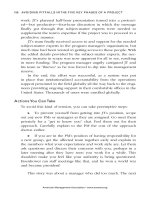Financing a small business the equity side of picture
Bạn đang xem bản rút gọn của tài liệu. Xem và tải ngay bản đầy đủ của tài liệu tại đây (233.62 KB, 12 trang )
Financing a Small Business
The Equity side of the
picture…
BUS 202 Financing_EQUITY
Spring 2006
Debt or Equity?
• DEBT
is borrowed
money…it becomes a liability on
your balance statement (long
term loan)
• EQUITY
is an “investment”
in your business (silent partner
or venture capital)
Remember the Accounting
Equation
Asset = Liabilities - Owners’ Equity
Equity vs. Debt Financing
Advantages
Debt Financing
Advantages:
• Relatively Easy &
Quick
• Maintain control &
ownership
• Interest & other costs
tax deductible
• May be able to save
money
Equity Financing
Advantages:
• Brings in more cash
• Share of financial risk
(partners)
• Less pressure &
restrictions
• May be able to
borrow more
Equity vs. Debt Financing
Disadvantages
Debt Financing
Equity Financing
Disadvantages:
• Interest Costs Expensive
• Risk of profits not
covering repayment
• Easy to abuse & overuse
• Must share financial
information
• Lender Restrictions &
Limitations
Disadvantages:
• Risk of destroying
personal relationships
• Give up part of profits
• Give up part of ownership
of business
• Give up some control of
business
• Personal sacrifices
• Loss of savings
Debt:
A Loan by any other name
Debt Financing is most frequently used when
there are minimal risks and the investment return
is acceptable to the lender.
Businesses that rely on debt financing are those
in earlier stages of business development (primary
& secondary levels of business growth)
There are two specific types of debt financing:
1) Conventional Loan Programs
2) Government Guaranteed Loan Programs
Equity Financing
• Most frequently used to fund emerging
businesses and to provide “seed” startup early stage and expansion financing.
• For businesses in their 2nd and 3rd level
of business development.
• Start-up businesses often have
challenges attracting traditional equity
investment.
• Start-ups often use the 3 F’s for equity
investment.
Tips for Tapping the Family & Friends
for Funds
Consider the impact the investment
will have on all parties
Keep the arrangement strictly
business
Keep it professional!
Settle the details upfront
Create a written document…put the
agreement in writing
Treat the money as “bridge” financing
Develop a payment schedule
Equity or “Risk” Capital
•Equity capital represents the personal investment of the
owner(s)…it is often called RISK capital.
•It is called RISK because the investors assume the primary risk
of losing their funds if the business fails.
•In the 1990’s entrepreneurs began to turn more to equity
financing to get their businesses up & running.
•Apart from personal savings, family and friends, equity capital is
normally tough for a start-up to obtain.
The Equity Ladder
1.
Start with your personal savings …lenders & investors
EXPECT you to reach into your pockets first!
2.
Three out of four start-ups tap their family members for
capital; followed by friends.
3.
Entrepreneurs can take on partners to expand the
capital foundation of their business.
4.
Angels fill a significant gap in the seed capital market.
5.
Venture Capitalists & Capitalist Firms purchase equity
positions in young businesses that have high-growth
potential
6.
Going Public- Public Stock Sale
What about Grants?
• Are you a for-profit or a nonprofit business?
• The SBA has SBIR Grant
(Small Business Innovative
Research) i.e. bio-tech
• Very limited amount of “seed”
grant funds for disabled retraining or disadvantaged
businesses from federal and
state agencies often tied to
creating jobs.
The Bootstrapping Method
• Start small and reinvest
the money in your
business
• Don’t quit your day job
• Start a business you “don’t
like” to get the capital you
need to start a business
you want (would not
recommend)
Other “entrepreneurial” methods to
grow your financing
• Internal Financing (customer
pays in advance)
• Factoring
• Consignment & Flooring
(inventory that doesn’t cost you)
• Concession (sub-lease)
• Vendor Credit (time is money)
• Trade for services (bartering)









